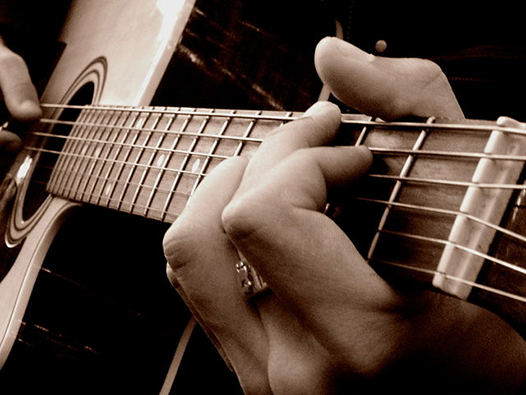
As a guitarist, you know how important it is to have a varied chord vocabulary to help keep your sound interesting. One way to add flavor to your playing is to incorporate suspended chords into your chord progressions.
A suspended chord creates subtle harmonic tension by swapping out the third note for another note. You've probably played a few suspended chords without even realizing it while you were messing around with chords. So let's expand your chord knowledge. Here are 7 tips to help you get clear on suspended chords—what they are and how they function:
1. How a chord is made. To understand what makes a suspended chord tick, you first have to have a grasp of how chords are built. The major and minor chords that you already know are made up of three notes—the root (or first note in the corresponding scale), third, and fifth. The third of a chord is what gives major and minor chords their character. The major triad formula is 1-3-5. The minor triad formula is 1-b3 (a flatted third)-5.
2. How a suspended chord is made. When you see the word "suspended" or its abbreviation "sus" (pronounced "suss"), the translation is no third note. A suspended chord substitutes another note (typically a fourth or second) for that all-important third note. The lack of the third's distinctive sound, which makes the chord either major or minor, means that sus chords can be played with or substituted for either. The formula for the sus4 chord is 1-4-5.
3. How suspended chords work. More often than not, the role of the suspended chord is that of a "passing chord." As the name implies, a passing chord is one that you 'pass through' on your way from one chord in a progression to another.
4. How suspended chords sound. Major chords sound happy. Minor chords sound sad. Suspended chords tend to sound tense. They have an ambiguous sound that is neither major nor minor. An unfinished, unresolved, something-needs-to-happen sound that creates dissonance. You can hear the tension a sus chord creates, and you can feel it release when the chord is changed back to a proper triad.
5. Get to know your sus chords. Make time to familiarize yourself with the sus4 chord of the chords you play most often. Be sure to listen to how they sound and experiment with them a bit. Throw them into your playing. Sometimes they will sound great and sometimes not. Make note of the situations and progressions where they work, and you will find yourself able to mix them into your playing even when the tablature or chord sheets you're working with don't call for them.
6. The sus2 chord. Once you understand the theory behind sus4 chords, sus2 chords are very similar. Instead of the root, fourth, and fifth in a sus4 chord, a sus2 chord contains the root, second, and fifth. Sus2 chords have the pattern 1-2-5.
7. When in doubt. The convention in music is to use the sus4 chord whenever you see a chord simply marked "sus." Dsus, for instance, would mean play Dsus4. The "4" is implied. This doesn't mean you can't play Dsus2 (and it doesn't hurt to hear what it sounds like), but it's a good idea to start with a sus4 whenever you're not sure which to play.
Be sure to check out the Guitar Tricks Chord Chart for more on how to finger suspended chords and their variations.